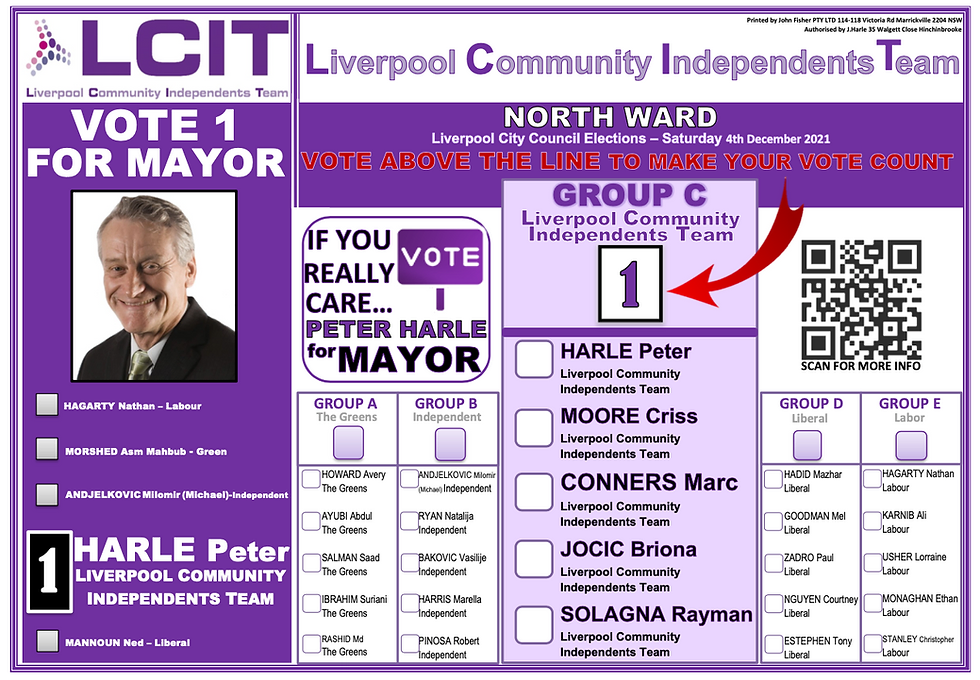For a thorough description of the Proportional Representation or PR system refer to this link: https://www.ecanz.gov.au/electoral-systems/proportional
Following is a “simplified overview:
Local government elections use a compulsory Proportional Representation system of voting, understanding its basics will give you a better chance of making your vote count and ensure that the most popular party or candidate is elected.
There are two ways of placing your vote, usually referred to as “above the line” or “below the line” voting. The ballot paper for Councillor Candidates usually has a thick black “line” above a group of candidates, with each group given a box and a letter. For example if there are seven groups, they would be labelled; Group A, through to Group G.
Each group can also have a description such as; Group C Liverpool Community Independents Team, Group E Labor or Group F Liberal etc. No description for a group means the candidates below the thick line have formed a group of “Independents”, with the uppermost candidate the first to be elected for that group. A quota based system determines the number of votes needed for a candidate to be elected.
Each group consists of a number of candidates below a thick line, usually equal to the number candidates to be elected in that ward and with a box next to each candidate. (For the Liverpool electorate that amounts to five candidates for each of two wards).
The most common way of voting is to simply place a “1” in the box above the group of your choice above the line. You can continue by placing a “2” in the group of your second choice and a “3” for your third choice and so on, however, do not number any boxes below the line.
Numbering boxes above and below the line may cancel or invalidate your vote!
The overriding criteria is that the Electoral Officer has to be satisfied that your voting intentions are clear.
The “preferences” are given by you the voter, NOT the group or Political Party. If you only place a “1” in a box above the thick line, your vote will only go to that group NO ONE ELSE! The group of your choice cannot give your vote to anyone else.
If you place a “2” in a box of your second choice, and a “3” in third choice etc., then those groups benefit from your vote in your preferred order. It simply means that if your first choice does not obtain enough votes, your vote can still be used to benefit your second, third or fourth choices. However if you only place a single “1” above the line, that is the end of your vote and cannot be used towards anyone else. While that may be your intention, it is not as democratic as it could be.
The “How to vote” papers handed out on election day by political parties or candidates can “advise” you how to place your numbers so that they obtain maximum advantage. That is one reason why YOU should decide who you want to represent you by placing numbers in boxes above the line in the order of your “preference”.
The tricky part, “below the line” voting.
You can also vote “below the (thick) line”. If you do, you must vote for at least 50% of the number of Councillors to be elected, in Liverpool that amounts to five Councillors per ward. Hence starting with the number “1” in the box next to the candidate of your first choice, a “2” in the box for your second choice and a “3” in the box for for your third choice and so on. If five candidates are to be elected the voter must choose at least three (more than 50% of the candidates).
There are major problems with this method from a “political” party’s point of view. The possibilities of this mode of voting are beyond a simple explanation due to number of variables. Hence my suggestion is “don’t vote below the line” unless you fully understand the consequences. A group that does not have a box above the line can only be voted for “below the line”, that is one reason why few “ungrouped” Independents or political parties will obtain enough valid votes to be elected.
The electoral system favours the “Party System”, that is the main reason why the Liverpool Community Independents Team formed a “Political Party”, without doing so we could not effectively compete with major political parties.
The Mayoral vote is much simpler, the voter simply places a “1” in the box next to their choice for Mayor. The voter can also continue by numbering the remaining boxes in the order they prefer if their first choice for Mayor does not obtain sufficient votes to be elected.
LCIT “How To Vote” brochure with suggested preferences, as used Local Council Elections.
You will receive two ballot papers, one large and one small. The large paper has all the Councillor Candidates listed, while the smaller ballot paper lists only Mayoral Candidates in the order shown on the right hand side of our “How To Vote” brochure links below.

Sample of How to Vote Southward
